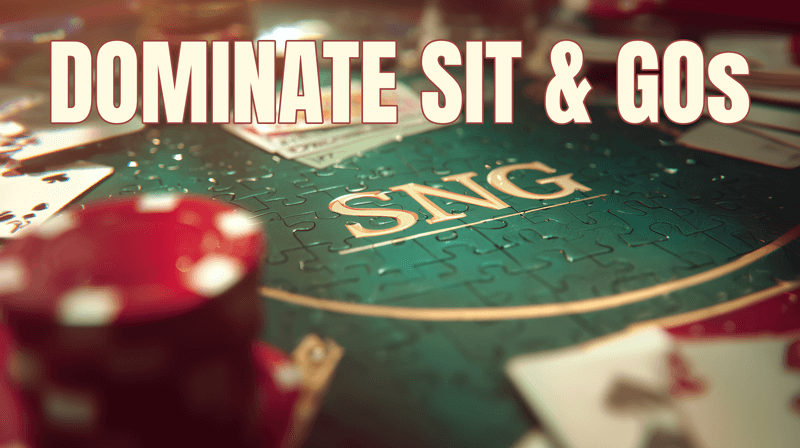Dominate Sit and Go Poker Course: How to Level Up Your SNG Tournament Game
Sit and Go poker tournaments, commonly called SNGs, have grown in popularity alongside the rise of online poker.
Their shorter format allow you to play tournament style poker without having to play for hours like in a full multi table tournament giving them the same time convenience of cash games.
During this free course we’ll teach you how to build a solid strategy to help you dominate SNG tournaments over time, by making better decisions and exploiting common mistakes made by less experienced players.
What Will I Learn? Course Outline
Sit and Go poker tournaments are a format that was basically unheard of in casino poker rooms (outside of single-table satellites) but are now very much in demand.
Some poker professionals choose to focus on Sit and Go tournaments rather than other formats like cash games or multi-table tournaments, and have found success through a disciplined and strategic approach.
During this Course we’ll teach you a strategy of how to play Sit n Go poker tournaments and consistently finish in the money with all the tools and information you need, including:
- The Five Sit and Go Strategy Stages
- How to Identify Softer Sit and Go Tables
- Advanced SNG Strategy Techniques
- How close out a Sit and Go with Heads Up Strategy
- How to Improve your long term ROI
- Poker Professor’s structured $1,000 SNG Challenge — with a focus on disciplined bankroll management
What is Sit and Go Poker?
Sit and go tournaments are named as such because there is no scheduled start time. Instead of registering in advance for a tournament that starts at a fixed time regardless of how many entries there are, the SNG starts when all of the seats have been filled. The field size is fixed, and the start time is flexible. At some poker sites, the wait for a low limit single table SNG can be less than a minute during peak times. Higher buy in tournaments do take slightly longer to fill in most cases.
Types of Sit n Go Tournaments
The single-table tournament (STT) is the most basic form of SNG. Created as a way for tournament players to play without the long time commitments necessary to play multi table tournaments, the STT has really found a niche in online poker. Since then, the single table SNG has evolved into multi table versions, seating as many as 180 players, but the basic single table SNG still remains the most popular.
- Single table SNG (STT) – will typically seat nine or ten players. The cost of entry consists of a buy in plus an entry fee. This is usually expressed as $10+1. The $10 buy in goes to the prize pool, and the $1 entry fee goes to the poker site as a fee for operating the game. Most single table tournament formats pay the top three players, and a common payout structure is 50% to first place, 30% to second, and 20% to third place.
- Multi table SNG (MTT) – will range in size and common MTT sizes will be 18 players (2 tables), 45 players (5 tables), 90 players (10 tables) and 180 players (20 tables). They work in exactly the same way as the single table SNG with the only difference being that as players are eliminated, tables are closed and the number of tables slowly reduces until you are just left with the final single table who fight it out for the money. The bigger the field size the bigger the prize pool however your odds of cashing in the tournament also get longer.
Structures of SNG Tournaments
There are two main types of structure to a Sit n Go tournament. Both of these are commonly found at online poker sites and you can really choose your preferred structure.
- Standard Structure – The first is the standard structure where the blinds increase every 10 minutes or so.
- Turbo Structure – The second is the Turbo structure, where the blinds increase more quickly — typically every 5 minutes. This results in a faster-paced tournament with fewer hands played at each blind level. While this offers the convenience of shorter sessions, it also increases the pressure on decision-making and introduces more variance compared to standard structures.
How to Follow this Course
The strategy revealed in this course is aimed at No Limit Texas Holdem Sit and Go tournaments with the standard structure and although it can also be applied to turbo SNG tournaments there is some variation you would have to apply to it to take into account the speed at which the ratio of blind size to your total stack changes.
Due to the top-heavy payout structure — where the top 3 finishers receive the majority of the prize pool — this guide focuses on strategies that aim to maximise your chances of reaching those top positions. The most optimum strategy to achieve this is to play tight early, cautiously on the bubble, and aggressively when in the money and this is the strategy that we will outline in more detail in this guide.
The guide will talk you through the 5 stages of a Sit and Go Tournament and the strategy that should be applied in each stage. It will also look at some advance SNG strategy situations to give you everything you need to be a successful SNG player.
We’ll also guide you through a structured bankroll challenge — starting with $50 and working toward an illustrative $1,000 target — designed to help you practise the strategies you’ve learned in the course and build disciplined bankroll habits, though actual results will naturally vary from player to player.
So if you’re ready to level up your Sit and Go game, let’s get started with the first lesson…

